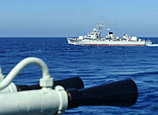
Three warships of China's North China Sea Fleet left a military port in Qingdao on Jan. 29 for routine open-sea training in the West Pacific Ocean, the Ministry of National Defense's information office said on Wednesday.
China is under fire every time it conducts naval training beyond the first island chain. However, Xia Liping, dean of the School of Political Science and International Relations at Tongji University, said that China is blameless in conducting such training to meet its national defense needs.
First of all, the Chinese Navy has shifted its attention from offshore areas to the open sea. It is necessary to conduct open-sea training at this stage. China conducted seven naval training exercises beyond the first island chain last year alone. Secondly, China is increasingly integrated with the world, and its foreign trade volume is on a steady rise. The country urgently needs a strong navy to ensure safe and smooth maritime transportation. Also, the training area includes the Miyako Strait, the Bashi Channel, and the sea area east of Taiwan, which is near the disputed islands. China's naval training in the high seas is in line with international law, and shows the country's determination to safeguard sovereignty and territorial integrity.
Xi Jinping, general secretary of the Communist Party of China, noted on Jan. 28 that China adheres to the path of peaceful development, but the country will never give up its legitimate rights and interests or sacrifice core national interests. The country should try to "make a difference," and gain a favorable environment for peaceful development.
It is worth noting that China has disclosed the number and names of the warships involved in this open-sea training as well as the specific training area and more than 20 types of exercises. This is a slap in the face for certain countries that enjoy criticizing the Chinese military for lack of transparency.
According to former U.S. Secretary of State Henry Kissinger, deterrence is based on three main factors: military strength, willingness to employ it, and effective information transmission. As the situation in the South China Sea and East China Sea is becoming increasingly complex, the Chinese Navy has flexed its muscles as a means of deterrence. "Deterrence is an effective way to avoid conflict," Xia said.
















 China's weekly story (2013.01.27-01.31)
China's weekly story (2013.01.27-01.31)


![]()
